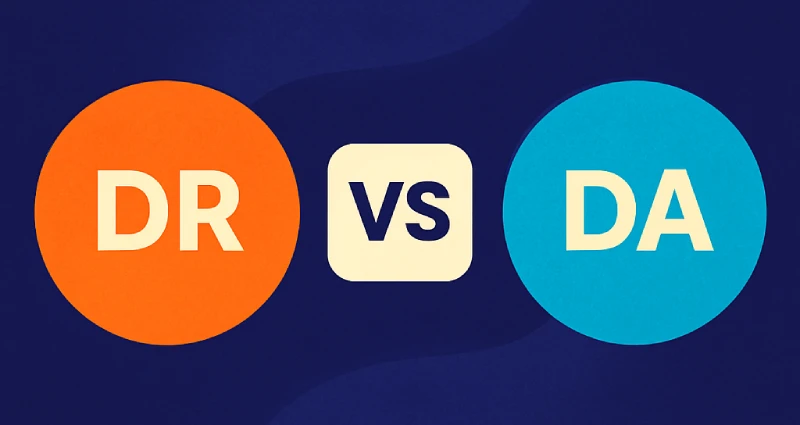
🔎 DA vs DR: Why These Metrics Still Matter for SEO Strategies
In the world of SEO, authority matters — but measuring it is not always straightforward.
Whether you’re planning a link building campaign, analyzing competitors, or qualifying publishing opportunities, you’ve probably come across metrics like Domain Authority (DA) and Domain Rating (DR). These numbers — often seen in SEO tools and link building platforms — help estimate how “strong” or trustworthy a domain is from a search engine’s perspective.
But while these scores are commonly referenced, very few professionals understand how they actually work, or when to trust one over the other. Even fewer know which one is more reliable in the current SEO landscape, and why.
If you’re serious about making informed decisions when it comes to off-page SEO, this guide will clarify where to focus your attention — and how to build real authority that drives results.
ℹ️ What Exactly Are DA and DR?
Both Domain Authority (DA) and Domain Rating (DR) are third-party SEO metrics that attempt to measure the overall strength of a domain — but each is built differently, and originates from a different tool provider.
Domain Authority (DA)
- Created by Moz, DA is a score from 1 to 100
- It predicts how well a website might rank in search results
- The score is calculated based on factors like MozRank, MozTrust, and the number of linking domains
- It includes a machine learning component that tries to simulate how Google ranks websites
DA is still widely used by marketers and agencies, particularly in legacy SEO workflows and outreach tools. However, its methodology is not fully transparent, and its update frequency is slower compared to other tools.
Domain Rating (DR)
- Developed by Ahrefs, DR also uses a 0 to 100 scale
- It focuses strictly on the strength of a domain’s backlink profile, especially unique referring domains
- The score reflects how your domain compares to others in the Ahrefs index
- DR updates more frequently and tends to respond more quickly to new backlinks
Because DR emphasizes link diversity and link quality over predictive ranking potential, many SEOs use it as a more objective authority signal — especially in technical SEO and link prospecting.
DA vs DR: What’s the Real Difference?
Although Domain Authority and Domain Rating are often mentioned side by side, their methodologies, purposes, and reliability vary considerably. Understanding these differences is key to using both metrics effectively in your SEO work.
1. Tools Behind the Metrics
- DA is developed by Moz, a platform known for its keyword tracking and SEO software
- DR is calculated by Ahrefs, one of the most respected tools for backlink analysis
Each score reflects the priorities and data sets of its respective platform.
2. What Each Metric Measures
| Metric | Focus | Score Basis |
|---|---|---|
| Domain Authority (DA) | Predictive ranking potential | Link quantity, MozTrust, internal links |
| Domain Rating (DR) | Raw backlink strength | Number of unique referring domains and their own DR |
While DA tries to estimate how likely a domain is to rank, DR simply evaluates how strong your backlinks are, without trying to guess SERP behavior.
3. Update Frequency and Responsiveness
- DA updates are less frequent and depend on Moz’s crawl cycles
- DR is updated more often due to Ahrefs’ faster and broader index
This means DR reacts more quickly to new backlinks or changes in your link profile — a valuable trait when you’re actively building authority.
4. Transparency and Trust in the SEO Community
- DA has become easier to manipulate, especially with link farms or low-quality guest post networks
- DR offers a more reliable picture of backlink health due to its focus on unique domains and link equity flow
💡 Quick tip: If you’re evaluating a potential backlink opportunity, always check both metrics — but weigh DR more heavily when backlink quality is your priority.
🤔 Why Domain Authority (DA) Was So Popular — And What Changed
For a long time, Domain Authority (DA) was the go-to metric for evaluating a website’s potential to rank. It was widely adopted across SEO tools, outreach platforms, and digital agencies as a standard for measuring a domain’s value.
This popularity wasn’t by accident — DA provided something the SEO world lacked: a single, simple number to represent domain strength. But as the digital landscape evolved, so did the expectations around what “authority” really means.
1. DA’s Strength Was Simplicity
- Easy to understand: a 0 to 100 scale
- Used widely for link prospecting and outreach filters
- Integrated into tools like MozBar, SEMrush, BuzzStream, and others
For many, DA became a shortcut to evaluate backlink opportunities — but shortcuts come with trade-offs.
2. Manipulation Became Common
As link building became more commercialized, many SEOs discovered ways to artificially inflate DA scores:
- Acquiring backlinks from low-quality directories and blogs
- Using expired domains with residual link juice
- Building private link networks (PBNs) solely to boost DA
The result? High DA scores that didn’t reflect actual organic traffic, content quality, or Google trust signals.
3. Google’s Evolving Algorithm Made DA Less Reliable
Today, Google considers a wide range of factors that go beyond basic backlink metrics, including:
- E-E-A-T (Experience, Expertise, Authority, Trust)
- Topical relevance and semantic relationships
- User engagement and content intent
DA hasn’t kept pace with this evolution. While it’s still useful in some contexts, it no longer reflects how Google actually evaluates a site’s trustworthiness.
4. Is DA Still Useful?
Yes — but only when used with caution. DA can still help in:
- Initial filtering of link prospects
- Comparing sites within the same niche
- Getting a rough estimate of domain strength — not a final verdict
💡 Important: Don’t rely on DA alone to guide your SEO or link building strategy. Use it alongside other metrics like DR, organic traffic, referring domains, and relevance.
🏆 Domain Rating (DR): A More Reliable Metric for Modern SEO?
As the SEO landscape became more complex, many professionals began to shift their attention from DA to Domain Rating (DR). Developed by Ahrefs, DR has gained credibility as a more objective and stable metric for evaluating backlink authority.
Why SEOs Trust DR More Today
- Update frequency: Ahrefs updates DR more frequently, reflecting changes in real time
- Focus on link diversity: DR emphasizes the number and quality of unique referring domains
- No attempt to simulate Google’s ranking: DR doesn’t try to predict SERP behavior — it simply measures raw link authority
This makes DR especially valuable for link building outreach and for analyzing the strength of potential backlink sources.
How DR Works (in Simple Terms)
Domain Rating is calculated based on:
- The number of domains linking to your website
- The DR score of each of those linking domains
- How many websites each referring domain links out to
In short: earning a backlink from a high-DR domain that links to very few sites is much more impactful than a link from a site with low DR or dozens of outbound links.
Limitations of DR
While DR is widely trusted, it’s not perfect. Here are some things to keep in mind:
- It still doesn’t measure traffic, engagement, or content quality
- It can be inflated by acquiring links from many low-authority domains
- It doesn’t consider topical relevance — a key factor for SEO impact
💡 Bottom line: DR offers a clearer picture of a domain’s backlink strength — but it must be interpreted with context. Used properly, it can be a powerful tool in building a healthy, scalable off-page SEO strategy.
⚙️ How to Use DA and DR in a Realistic Way
It’s easy to fall into the trap of obsessing over numbers. But the truth is: DA and DR are just indicators — not absolute truths about your website’s SEO health.
To get real value from these metrics, they should be used as part of a broader analysis, not in isolation. Here’s how professionals use DA and DR in practice:
1. Vetting Link Building Opportunities
When evaluating a domain for potential backlink placement, consider:
- DR or DA score: Use it to filter out very low-authority sites
- Organic traffic: Check if the domain actually ranks for anything
- Topical relevance: Ask if the site’s content aligns with your niche
High DR alone is not enough. A backlink from a high-DR domain that covers unrelated content may bring less value than one from a lower-DR site within your vertical.
2. Tracking Progress Over Time
DA and DR can also serve as reference points when monitoring your site’s off-page growth:
- Have you gained new referring domains?
- Has your domain’s score improved after a link building campaign?
- Are you outperforming competitors in authority metrics?
Used this way, these metrics help visualize progress and validate your SEO investment — even if they don’t directly affect Google rankings.
3. Comparing Competitor Profiles
DA and DR are especially useful in competitor audits. By comparing authority metrics between domains, you can:
- Identify competitors with stronger backlink strategies
- Uncover gaps in your current link profile
- Find realistic benchmarks for outreach goals
What to Avoid
- Making decisions based solely on DA or DR
- Assuming higher scores always equal better results
- Ignoring traffic, content quality, or link context
Context is everything in SEO. DA and DR are useful tools — but only when used as part of a complete strategy that considers relevance, quality, and actual performance.
🤔 Are These the Only Metrics That Matter in SEO Today?
No. While DA and DR are among the most commonly referenced authority metrics, they are not the only ones — and in some cases, not even the most relevant.
Several other SEO tools offer alternative ways to evaluate the strength and credibility of a domain. Depending on your analysis goals, it can be helpful to consider:
- Trust Flow (TF): A Majestic metric that measures the quality of backlinks based on their proximity to highly trusted sources.
- Citation Flow (CF): Also from Majestic, CF focuses on link quantity — useful when paired with TF to evaluate the balance between volume and trust.
- Spam Score: Provided by Moz, this metric estimates the likelihood of a domain being penalized by Google, based on its backlink profile and other risk factors.
- Authority Score (AS): Offered by Semrush, this combines multiple factors — including backlinks, organic search traffic, and site health — to assign an overall domain strength score.
Each of these metrics has its own methodology, scope, and use cases. They shouldn’t be compared side by side but rather interpreted based on what you’re trying to evaluate: link quality, risk, traffic potential, or topical alignment.
And beyond these, there are still other indicators — including proprietary metrics and AI-driven scores — that may be useful in specific industries, local SEO, or technical audits.
🎯 So, Which Metric Should You Trust More?
Each authority metric — whether it’s DA, DR, TF, or AS — offers a different perspective. What truly matters is understanding what each one measures and using them in the right context.
Rather than looking for a “perfect score,” focus on building a strong, relevant, and diverse link profile that drives real organic visibility. The metrics will follow.
Here’s what we recommend:
- Use DR and TF to evaluate link strength and trust
- Use Spam Score to avoid risky domains in link building
- Use DA and AS for benchmarking and competitor comparisons
At The Key SEO, we help businesses in Portugal and across Europe build real authority — not just higher scores. If you’re ready to move beyond surface-level SEO and work with a team that understands what truly drives rankings, let’s connect.
Request a Free SEO Consultation
How The Key SEO Builds Real Authority — Beyond DA and DR
While DA and DR can help benchmark your site’s authority, they are not the end goal. At The Key SEO Agency, we don’t chase vanity metrics — we focus on real authority signals that move the needle in competitive markets.
What We Prioritize Instead
- Links from relevant, high-quality websites — not just high-DA or DR domains
- Topical authority through content clusters and semantic optimization
- Link diversity across domains, geographies, and content types
- Backlinks that bring real traffic — not just score points
Our SEO strategies combine advanced link building techniques, deep competitor analysis, and editorial-level content to build a link profile that naturally boosts your authority across multiple metrics — including DA, DR, and trust-based signals.
Transparent Reporting & Strategic Growth
We track all relevant metrics — but we also go deeper. Every client receives:
- Monthly reports with live backlink data and authority scores
- Insights on link context, anchor diversity and referral performance
- Progress tracking aligned with organic growth goals
If your current strategy is focused only on increasing DA or DR, you’re leaving potential on the table. Let’s talk about building real SEO authority — with measurable business results.

